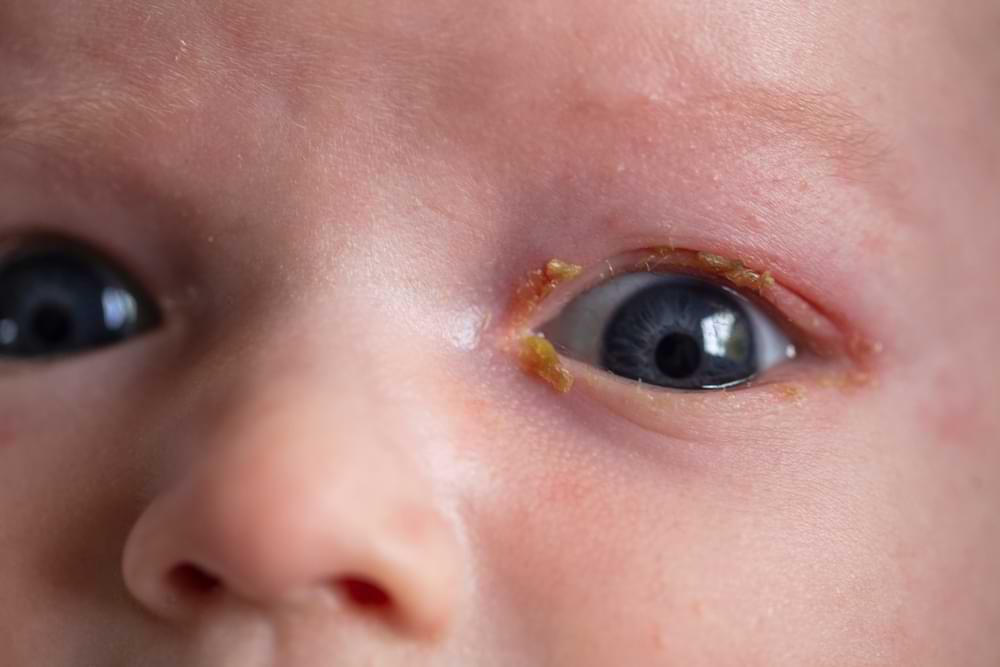Newborn Eye Infection Treatment: What To Expect

Your baby cries, squints, and wakes up with sticky eyes all the time, but how do you know when it’s more than just something “normal for babies”? Their tear ducts are still developing, and their eyes are exposed to bacteria from birth, putting them at risk for infections like neonatal conjunctivitis.
Also called ophthalmia neonatorum, neonatal conjuctivitis affects 2% to 12% of newborns in their first 28 days. Some cases clear up on their own, but others can lead to serious complications if left untreated.
I’m Minh Van Tran, Principal Optometrist at VisionPro Optometrists, and I’ve spent over 20 years helping parents protect their children’s vision. I’ve seen how quickly a minor eye issue can turn into something more serious without the right care.
Let’s go through the causes, symptoms, and newborn eye infection treatment options so you’ll know when to act.
Key Takeaways
- Identify symptoms early – redness, swelling, and discharge signal possible infection.
- Treat infections quickly to prevent long-term eye damage.
- Massage blocked tear ducts and clean with saline to manage sticky eye.
- Wash hands before touching a newborn’s face to reduce infection risk.
- Schedule follow-ups if needed to monitor vision after a severe infection.
Causes of Newborn Eye Infections
Newborns are particularly vulnerable to eye infections. Their immune systems are still developing, and their delicate eyes are easily affected by bacteria, viruses, and irritation. Let’s break it down.
Bacterial Infections
Some bacterial infections are passed from mother to baby at birth. Chlamydia and gonorrhoea are two of the most common culprits. If left untreated, these infections can lead to serious complications, like corneal damage and permanent vision issues. A thick, pus-like discharge from both eyes is a major warning sign.
Viral Infections
The herpes simplex virus can also cause serious eye infections in newborns. Symptoms include watery discharge, redness, and swelling, sometimes accompanied by blisters on the skin near the eyes. These infections can spread quickly, making early detection and antiviral treatment essential.
Blocked Tear Ducts (Sticky Eye)
A blocked tear duct is one of the most common causes of eye discharge in newborns. If your baby has sticky eye, you might notice a yellowish discharge that sticks to the eyelashes, especially after sleep. Unlike infections, sticky eye doesn’t usually cause redness or swelling. Gentle cleaning with saline and a warm compress can help.
Chemical Irritation
Newborns are often given antibiotic eye drops at birth to prevent infections. However, these drops can sometimes irritate their eyes, giving off a red and slightly swollen appearance in the first 24 to 48 hours. If it doesn’t have any discharge, it could be simply a mild reaction that will clear on its own.

Recognising Symptoms of Infections
Spotting an infection early makes all the difference. Likewise, a quick response can prevent complications and ensure proper healing. The challenge? Newborns can’t tell us when they don’t feel 100%. Here’s what you should look for:
Common Signs
- Redness and swelling around the eyelids: A slight puffiness might be normal, but if the swelling increases or spreads, it could signal an infection.
- Watery, yellow, or green discharge: A small amount of clear fluid can be normal, but thick, persistent discharge (especially if it keeps coming back after each wipe) needs attention.
- Sensitivity to light: If your baby turns away from bright light or keeps their eyes tightly shut, this could indicate discomfort or inflammation.
When to Seek Urgent Medical Attention
Some eye infections are mild and clear up on their own. Others progress rapidly and demand medical intervention. So, how do you tell the difference?
- Pus-like discharge that returns after cleaning. If you find yourself wiping discharge repeatedly, only for it to build up again, then it’s likely an infection.
- Redness that extends beyond the white part of the eye. A mild irritation should stay localised. If the redness spreads, the infection is more aggressive.
- Severe swelling preventing the eye from opening. If your baby struggles to open one of their eyes because of swelling, there’s likely a significant issue.
- If there’s cloudiness or haziness in the cornea.
- A high fever or any signs of overall illness (lethargy, difficulty feeding, unusual irritability) should also prompt urgent action.
Newborn Eye Infection Treatment
Depending on the cause of the infection, care may involve antibiotic drops, antiviral medication, or simple at-home remedies like tear duct massage.
Antibiotics for Bacterial Infections
If I confirm a bacterial infection, antibiotic eye drops or ointments will usually be prescribed. In more severe cases, oral or intravenous antibiotics may be necessary. Treatment typically lasts one to two weeks, with noticeable improvement within a few days.
Antiviral Medication for Viral Infections
If it’s herpes-related, antiviral medications are a must. These may be given as eye drops, oral medication, or intravenously in severe cases. Since viral infections can spread fast, early treatment is key to make sure there are no complications.
Managing Blocked Tear Ducts at Home
If your baby has sticky eye, you can help with:
- Gentle massages between the inner corner of the eye and the nose. This can help open the tear duct naturally.
- Cleaning with saline solution with a clean cotton pad. This removes any discharge and prevents bacterial build-up.
- Watching for symptoms. If redness or swelling develops, an infection may be present, and a professional evaluation is necessary.
To learn more about the correct procedure for massaging newborn tear ducts (a.k.a. Crigler massage) watch the following video from Dr. Rupa Wong.
Relieving Symptoms of Chemical Conjunctivitis
If your newborn’s eyes are red but there’s no discharge, and the irritation appeared shortly after birth, it may be a mild reaction to the antibiotic drops given at delivery. If symptoms persist beyond 36 hours, I recommend an eye check-up to rule out any other causes.
Preventing Eye Infections
Routine screenings, newborn eye prophylaxis, and good hygiene all play a role in reducing infection risks.
Maternal Health and Prenatal Screening
Prevention starts before birth. Sexually transmitted infections (STI) screening while pregnant is necessary, as undiagnosed infections can lead to serious newborn complications. If an infection is detected early, treatment can greatly reduce the risk of passing it to your baby.
Routine Newborn Eye Prophylaxis
Hospitals routinely administer antibiotic eye drops at birth to reduce the risk of bacterial infections. Erythromycin is commonly used, which significantly lowers the likelihood of gonococcal and chlamydial paediatric conjunctivitis.
Hygiene Practises for Parents and Caregivers
Good hygiene is one of the simplest and most effective ways to lower the risk of infections. Here are a few steps I always recommend to parents:
- Wash your hands thoroughly before touching your baby’s face, especially if you’ve been in contact with others.
- Keep the eye area clean with a soft, damp cloth to gently wipe off any discharge.
- Avoid contact with contagious conjunctivitis in other family members—if someone in the household has an eye infection, take extra precautions to prevent spread.
Potential Complications of Untreated Infections
Left untreated, newborn eye infections can lead to serious long-term issues.
Vision Loss and Corneal Damage
Severe bacterial infections can cause irreversible damage to the cornea. This leads to scarring and long-term vision problems. Once the cornea is affected, vision clarity may never fully return. That’s why early intervention is non-negotiable; treating an infection before it spreads prevents complications that could impact your child’s sight for life.
Systemic Infections and Other Health Risks
An untreated gonococcal eye infection doesn’t stay in the eye; it can also enter the bloodstream, which can lead to sepsis or meningitis. These conditions progress really fast in newborns. The best way to prevent this? Immediate medical treatment.
Long-Term Effects on Eye Health
Severe infections in infancy don’t always end once the symptoms fade. Scarring, misalignment, or even chronic inflammation can develop later in life. That’s why eye care is essential for babies who’ve experienced significant infections. Regular check-ups allow us to track any subtle vision changes and address potential problems before they escalate.
Final Thoughts
Newborn eye infection treatment should be taken seriously. Redness, swelling, or discharge could mean a mild issue, or it could be something that needs urgent care. Catching it as soon as possible can prevent serious complications. Bacterial and viral infections need medical treatment, while blocked tear ducts often clear up with home care. Good hygiene and routine check-ups help keep your baby’s eyes healthy.
At VisionPro Optometrists, we’re here to help. Let’s make sure your baby’s vision starts strong.
Click on the “BOOK AN APPOINTMENT” button OR call either our St. Albans (03) 9364 5509 or Footscray (03) 9687 8787 optometry practices.
Want to test your knowledge about Children’s Vision?

Minh gained his Bachelor of Optometry in 2000, and his Certificate in Ocular Therapeutics (ACO) in 2016.
He started VisionPro Optometrists in 2008 and has been Principal Optometrist ever since, working in both the Footscray and the St Albans practices.
Minh is a member of Optometrist Association Australia and the ACO. He always strives to achieve the highest standard of professionalism when delivering eyecare to all his patients.
Minh’s special areas of interest include ocular diseases and management, children’s vision and contact lens fitting. Minh enjoys travelling and reading in his spare time.

